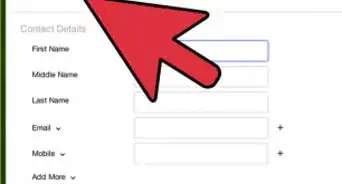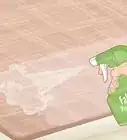This article was co-authored by wikiHow staff writer, Amy Bobinger. Amy Bobinger has been a writer and editor at wikiHow since 2017. She especially enjoys writing articles that help people overcome interpersonal hurdles but frequently covers a variety of subjects, including health and wellness, spirituality, gardening, and more. Amy graduated with a B.A. in English Lit from Mississippi College in 2011 and now lives in her hometown with her husband and two young sons.
There are 9 references cited in this article, which can be found at the bottom of the page.
This article has been viewed 17,880 times.
Learn more...
Handmade quilts are one-of-a-kind works of art, and they are highly sought after by collectors and homemakers alike. Whether you make your own quilts or you have a collection of vintage quilts you’d like to sell, listing your quilts online can help you find buyers from around the world!
Steps
Photographing Your Quilt
-
1Iron or steam your quilt before you take a picture. If your quilt is wrinkled, your photograph will look sloppy. If you have a handheld steamer, hang up your quilt and steam it to remove any wrinkles. Otherwise, iron it on low heat.[1]
- You may also want to run a lint roller over your quilt to remove any stray threads.
-
2Take your pictures with a digital camera. You don’t need the most advanced camera on the market to get great pictures of your quilt. However, a digital camera will allow you to see instant feedback on how your pictures are turning out, and you can make adjustments if you need to.
- A smartphone camera should be sufficient if you take the time to get the lighting and focus right. If you need to, read the manual that came with your smartphone to learn how to adjust the settings on your camera.
Advertisement -
3Use natural light for your photograph. You might have to wait for nice weather to get the shot you want, but natural light is the best way to show off your quilt. Using indoor lighting can make your photograph look yellow and may alter the colors of your fabric.[2]
- If you’re shooting inside, try to find a location near a big window, or open your exterior doors to let in as much light as possible.
- If you shoot outside, try to find a spot that’s out of direct sunlight, which can wash out the colors of your quilt.
-
4Create a simple backdrop to show off your quilt. If you don’t have a wall large enough to display your quilt, make your own backdrop from poster board, beadboard, contact paper, or even pieces of laminate flooring.[3]
- Solid, neutral colors are best for a backdrop, but you can get creative different textures and colors to create interesting effects, like shooting against a brick wall.
-
5Use binder clips or masking tape to hang your quilt so it doesn't tear. Binder clips are a great way to attach your quilt to a line or a thin backdrop, while heavy-duty masking tape is ideal for hanging your quilt from a wall.[4]
- If you need to, you can crop or photoshop the clips or tape out of your picture, or you can roll the tape so that you can use it on the back of the quilt where it can't be seen.
-
6Drape your quilt over a ladder, bed, or other furniture to show different angles. If you want a more realistic shot of your quilt, try to show it somewhere that it might be found naturally, like draped over the arm of a couch or at the foot of a bed. Take the time to arrange it so that you can see the details of the quilt.
- You can also hang the quilt from a blanket ladder for a stylish drape that will show off the fabric.
-
7Stage the photograph so it looks attractive. Staging a shot means composing all of the elements so they look balanced. Eliminate distracting details from your photo, but feel free to add artistic touches like fresh flowers or a rug in a color that coordinates with your quilt.[5]
- Try to follow the rule of thirds, meaning you divide the image with 2 horizontal and 2 vertical imaginary lines, then stage the quilt so it sits at the intersection of those lines.
-
8Aim your camera at the middle of the quilt for a square shot. You may have to hang your quilt up high, or you might prefer to crouch down, but if you’re trying to get your quilt to look square, you should shoot the picture with your camera even with the middle of the quilt.[6]
- If you’re going for an artistic look or a detail shot, feel free to experiment with different angles.
Setting the Price
-
1Calculate the cost of your materials. Quilting-quality fabric can easily cost around $13 USD a yard, but that’s only a fraction of the cost of crafting a quilt. You will also need to factor in the cost of backing fabric, thread, batting, binding, fusible web, and anything else you used in the fabrication of your quilt.
- You may even want to factor in the depreciation of some of your equipment, like your sewing machine and needles.
- The materials needed for a 68 by 94 inches (170 cm × 240 cm) quilt will likely cost at least $150 USD.
-
2Determine your labor cost per hour. Only you can decide how much your time is worth. Some quilters sell their work for just the cost of materials, but this makes it harder for other quilters who feel they deserve to be compensated for their time. For the most part, the more experience you have making quilts, the more you should charge per hour.[7]
- If you’re selling the very first quilt you ever made, you may want to use your local minimum wage (for instance, $7.25 in most areas of the U.S.) to determine your rate. If you’ve been making quilts for years and you know your work is high-quality, you should compare your rate to that of other skilled craftsmen.
- Skilled carpenters, for instance, earn around $23/hour in the U.S.[8]
- Once you come up with your hourly rate, keep track of how long it takes you to create the quilt, then multiply your rate by the number of hours to get your final labor cost.
-
3Consider compensating yourself for any commission you’ll have to pay. Most online shops charge the seller a commission in exchange for listing their items. If you’ll have to pay a commission, you may want to include this in the price of your quilt.
- Some quilters consider this one of the costs of doing business, and opt to cover the commission out of their own pockets.
- The commission for a sale on Etsy, for instance, is 3.5%.[9]
- Most sites charge the buyer for shipping separately from the total cost of the item.
-
4Research similar quilts on auction sites if you’re selling vintage quilts. If you’re selling a quilt that you didn’t make yourself, it can be harder to calculate the value. Look online for quilts from the same time period or made in a similar pattern, then compare the prices of several different options to try to come up with a base price.
- If you know who made the quilt, try searching for other quilts by the same person or region to determine their value.
Listing Your Quilt
-
1Sell your work on an auction or crafting site for the easiest option. There are a number of different sites which allow people to sell their handmade goods. You may want to list your items on a site specifically for quilts, or one which attracts a broader range of customers.[10]
- This is a great way to make your work available to customers who might not see your quilts otherwise.
- Before you list your items, make sure you know what commission will be taken out, how quickly you can expect to be paid, and if there are any quotas you will be expected to meet.
- Some popular sites include ebay, Etsy, and ArtFire.
-
2Create your own website if you want full control over the process. You will either have to hire a web designer to build your company webpage from scratch, or you can choose a hosting service which provides templates.[11]
- Be sure that your site includes a merchant software that will allow you to process credit cards so customers can order directly from your website.
- If you have your own website, you will be responsible for driving all of the traffic to your site yourself.
-
3Advertise yourself on social media. Social media is a powerful tool for growing a small business. Post pictures of your quilts, along with information on how you can be contacted if someone wants to purchase one of your quilts.
- If you’re relying on social media, keep in mind that unique patterns and bold colors tend to make more of an impression when people are scrolling through their feed.
-
4Promote your work on quilting forums. Some quilting websites will allow you to post pictures of your work. However, make sure you read the community guidelines before you do this, since some don’t allow solicitation.
- Popular quilting forums include forum.apqs.com, https://www.quiltingboard.com, or https://www.artisticthreadworks.com.
-
5Sell your patterns if you want to keep your quilts. If you love making quilts but you’d rather give them to your friends and family, consider drafting your own patterns and selling them instead. This is a popular way for quilters to make a little extra income, and there are a number of quilting sites where you can list your patterns.[12]
- If you create your own quilt patterns, you can list them on some of the same sites where you would sell your handmade quilts, including Etsy and ebay.
- Patterns for a large quilt usually sell for around $10 USD.
References
- ↑ https://community.themodernquiltguild.com/resources/quilt-photography-5-tips-improve
- ↑ https://www.craftsy.com/quilting/article/how-to-photograph-your-quilts/
- ↑ https://www.simplesimonandco.com/2017/02/10-tips-for-photographing-quilts.html/
- ↑ https://www.simplesimonandco.com/2017/02/10-tips-for-photographing-quilts.html/
- ↑ https://www.simplesimonandco.com/2017/02/10-tips-for-photographing-quilts.html/
- ↑ https://www.simplesimonandco.com/2017/02/10-tips-for-photographing-quilts.html/
- ↑ http://www.sewmamasew.com/2014/01/placing-a-value-on-your-quilting/
- ↑ https://www.bls.gov/oes/current/oes472031.htm
- ↑ https://www.etsy.com/sell
About This Article
Before taking pictures of your quilt, steam or iron it to remove any wrinkles. Hang your quilt in an area with plenty of natural light, such as near a window or an open door. Use tape or binder clips to hang your quilt from a solid-colored backdrop, or drape it over a ladder or a piece of furniture. Aim your camera at the middle of the quilt if you want it to look square in the picture, or experiment with different angles for artistic shots! For tips on listing your quilt on auction or craft sites, keep reading!







































































